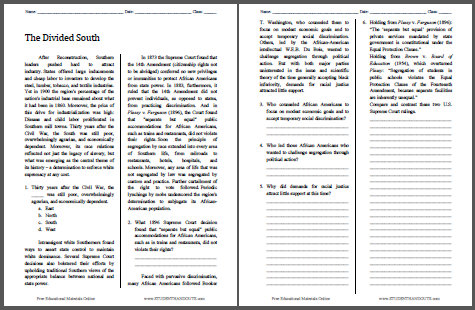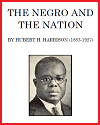After Reconstruction, Southern leaders pushed hard to attract industry. States offered large inducements and cheap labor to investors to develop the steel, lumber, tobacco, and textile industries. Yet in 1900 the region's percentage of the nation's industrial base remained about what it had been in 1860. Moreover, the price of this drive for industrialization was high: Disease and child labor proliferated in Southern mill towns. Thirty years after the Civil War, the South was still poor, overwhelmingly agrarian, and economically dependent. Moreover, its race relations reflected not just the legacy of slavery, but what was emerging as the central theme of its history – a determination to enforce white supremacy at any cost.
 Intransigent white Southerners found ways to assert state control to maintain white dominance. Several Supreme Court decisions also bolstered their efforts by upholding traditional Southern views of the appropriate balance between national and state power. Intransigent white Southerners found ways to assert state control to maintain white dominance. Several Supreme Court decisions also bolstered their efforts by upholding traditional Southern views of the appropriate balance between national and state power.
In 1873 the Supreme Court found that the 14th Amendment (citizenship rights not to be abridged) conferred no new privileges or immunities to protect African Americans from state power. In 1883, furthermore, it ruled that the 14th Amendment did not prevent individuals, as opposed to states, from practicing discrimination. And in Plessy v. Ferguson (1896), the Court found that "separate but equal" public accommodations for African Americans, such as trains and restaurants, did not violate their rights. Soon the principle of segregation by race extended into every area of Southern life, from railroads to restaurants, hotels, hospitals, and schools. Moreover, any area of life that was not segregated by law was segregated by custom and practice. Further curtailment of the right to vote followed. Periodic lynchings by mobs underscored the region's determination to subjugate its African-American population.
Faced with pervasive discrimination, many African Americans followed Booker T. Washington, who counseled them to focus on modest economic goals and to accept temporary social discrimination. Others, led by the African-American intellectual W.E.B. Du Bois, wanted to challenge segregation through political action. But with both major parties uninterested in the issue and scientific theory of the time generally accepting black inferiority, demands for racial justice attracted little
support.
Click here to print.
Answer Key: (1) C - South; (2) Plessy v. Ferguson; (3) Booker T. Washington; (4) W.E.B. DuBois; (5) Both major political parties were uninterested in the issue and scientific theory of the time generally accepted black inferiority; (6) Answers will vary. |
 Intransigent white Southerners found ways to assert state control to maintain white dominance. Several Supreme Court decisions also bolstered their efforts by upholding traditional Southern views of the appropriate balance between national and state power.
Intransigent white Southerners found ways to assert state control to maintain white dominance. Several Supreme Court decisions also bolstered their efforts by upholding traditional Southern views of the appropriate balance between national and state power.













